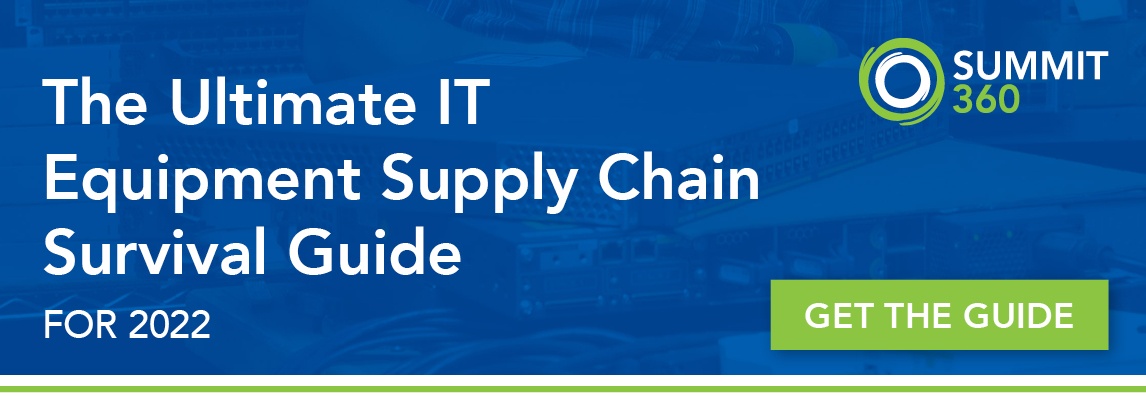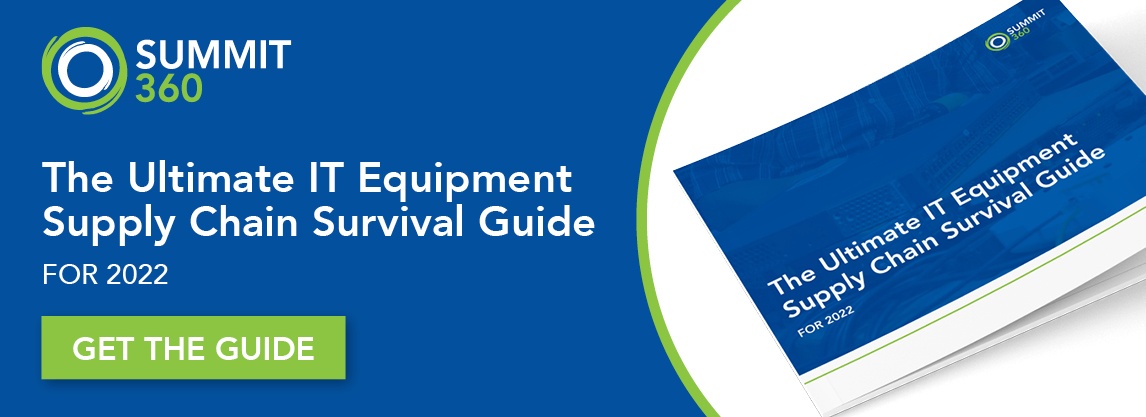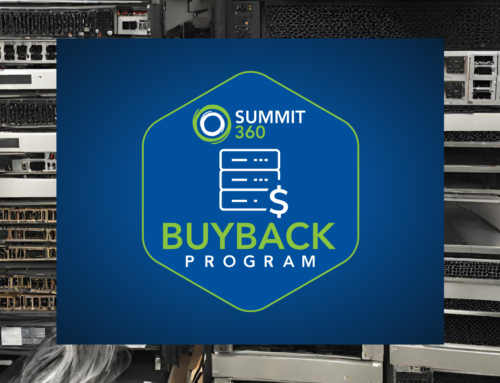Can you imagine waiting nearly a year after purchase to receive your networking equipment? In 2022, the answer to that question is yes. And that’s if you’re doing well. According to Gartner, some companies wait more than 400 days for their new network equipment to arrive.
These unusual lead times result from the pandemic, worldwide IT equipment supply chain disruptions, computer chip shortages, and trade tensions. And that means companies are under pressure on various fronts while also navigating a tremendous amount of change.
This guide offers IT leaders some background on the supply chain crisis, shares predictions on how long it will last, and tips on getting the networking equipment you need in the meantime.
What caused the IT equipment supply chain crisis?
The pandemic set off a complex chain reaction still rippling through the world’s supply chain. In the early days of COVID, manufacturing facilities shut down in major production centers worldwide. The closures led to production delays and backlogs that affected nearly every industry.
At the same time, a computer chip shortage disrupted the availability of smart products across categories, including laptops. (Thankfully, the chip shortage has improved except for the automobile industry. But it hasn’t resolved all of the challenges in the IT equipment marketplace.)
Production delays became worse as employers struggled to find talent. Then, ports, warehouses, and transportation companies couldn’t keep pace with logistics. Combined, all of these factors exposed inefficiencies across the network of vendors most companies rely on.
While these changes were happening, consumers and companies still needed goods and wanted new products more quickly than ever. Operations are becoming more complex to meet higher expectations. Plus, manufacturers feel pressure to innovate and adopt Industry 4.0 strategies like smart factories, artificial intelligence, and robotics.
Is the IT equipment supply chain crisis improving?
BDO just released findings from their 2022 Middle Market CFO Outlook Survey, which polled 600 Chief Financial Officers on their plans and predictions for the year ahead. Eighty-four percent of CFOs at organizations see supply chain disruptions as either a moderate or severe risk. These CFOs also said the supply chain is their #1 business risk for 2022.
Global Trade Magazine cautions, “while there is somewhat smoother sailing on the horizon, international trade waters will remain choppy in 2022 as logistics issues and government actions continue.”
Similarly, a New York Times think piece about the supply chain predicted a return to normal is unlikely in 2022.
These findings and predictions offer Chief Technology Officers (CTOs) little solace when they’re eager to advance their company’s digital transformation.
How should IT departments plan for the next 12-18 months?
So, where does a high likelihood of continued supply chain disruption leave IT leaders? In a recent blog post, we covered the importance of managing budgets carefully, planning further ahead, and considering alternative sales channels. We also recommend creating efficiencies and extending your time horizon if necessary.
- Manage budgets carefully – In this environment, dusting off a previous AOP budget and adding 10% isn’t going to give you a realistic view. Your top-of-range estimates need to be higher, and you should be prepared to pay more than you’ve paid in the past. In addition, you should expect to pay a premium for anything you need quickly (if it’s available).
- Plan further ahead – Given this, we recommend thinking through your hardware needs as soon as possible to estimate what you’ll need in the next 6-12 months – whether that’s phones, servers, or laptops. Then, place your order as soon as possible. You’ll still need to wait, but at least you’ll be in the queue. And don’t forget to build plenty of buffer into your project timelines.
- Consider alternate sales channels – With traditional channels under pressure, more companies are open to sourcing IT equipment through alternative channels, including independent resellers, refurbished equipment dealers, and strategic sourcing.
- Create efficiencies – Look for ways to save operational costs so you can redeploy those budget dollars elsewhere or invest for the future. For example, you could sell your used IT equipment to the secondary market or invest in refurbished products to see you through the IT equipment supply chain crisis (e.g., if you need more storage).
- Extend your time horizon – We know it’s not your first choice to slow down a project. We don’t like that option either. But if you can’t procure the IT equipment you need during this supply chain crisis, you may not have a choice. Our recommendation is to reprioritize projects often and stay fluid.
How can I find an alternative IT equipment supply chain solution?
If you’ve always purchased your networking equipment through a traditional reseller, we understand if purchasing equipment through an independent reseller gives you pause. IT expenditures can be significant, so trust needs to be high. Here’s how we recommend you vet any potential independent resellers for used or refurbished IT equipment.
Years of experience
Given the complexity of today’s supply chain, you’ll want to find a partner with a minimum of 10 years of industry experience. More experience is certainly better in this market, and we’re proud to have more than 30 years of experience.
One significant advantage to a more experienced partner is they’re more likely to have established processes and protocols, which should increase your confidence. This is especially important if you’re in a highly regulated industry.
Network of trusted vendors
Along with having years of experience, you want a partner who has a trusted and reputable network of vendors through which they source equipment. On average, we’ve worked with our major vendors for more than 30 years.
Guarantees and warranties
Ask potential vendors whether they offer any guarantees or warranties on their equipment. It’s common to provide these in the secondary market. As a benchmark, we offer a lifetime warranty that includes advance replacements to keep you up and running.
Available tech support
If you don’t have an in-house IT service team, you’ll want to find a secondary vendor that offers post-purchase tech support. This is especially important if you’re purchasing servers, storage, and network devices.
Our Summit 360 Global Care program is an add-on service that includes 24/7/365 tech support for far less than you’d pay an OEM.
Track record with similar companies
Finally, you want to make sure any potential partners have worked with companies similar to yours and are familiar with the unique challenges of your industry and revenue level.
What benefits do alternative suppliers offer?
Find the equipment you need
Through our strong network of independent resellers, refurbished equipment dealers, and strategic sourcing partners, we can find the network equipment you want and need.
Get the equipment you need faster
On average, it’s taking us about a week to source refurbished networking equipment right now. This is, of course, always subject to change. But it gives you an idea of how much faster you can achieve your goals by going the secondary route.
Maximize your IT budget
If rising costs and inflation are putting additional pressure on your budget, you should know that secondary equipment offers a strong value. In general, you can save up to 50% off the retail price for new equipment and still be able to upgrade your network environment.
Enjoy peace of mind knowing you have warranty coverage
From our warranties to the way we support the refurbished hardware we provide, we back up everything we sell so that you can trust in its reliability and integrity.
Need a partner you can trust?
We know how important reliability, security, and cost are to you. That’s why we deliver for our clients every single time. If you need a partner you can trust to navigate this IT equipment supply chain crisis and meet your business goals, let’s connect – contact us today.






